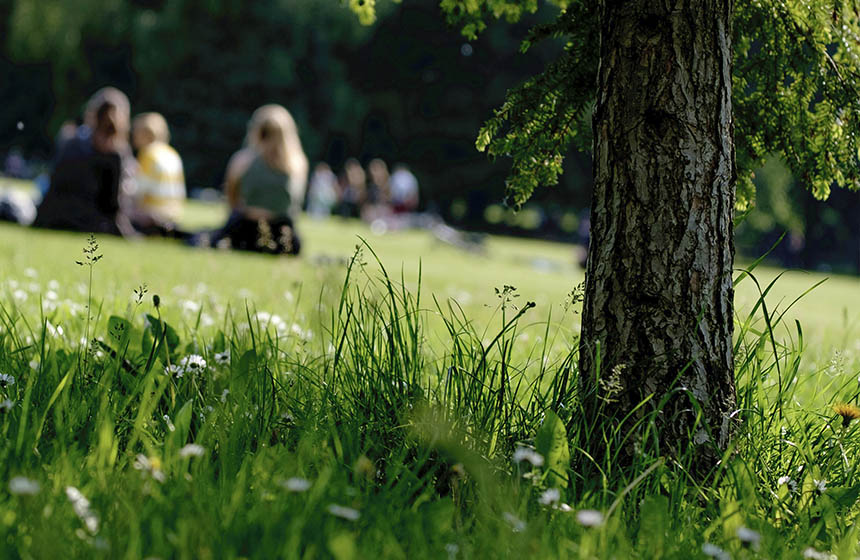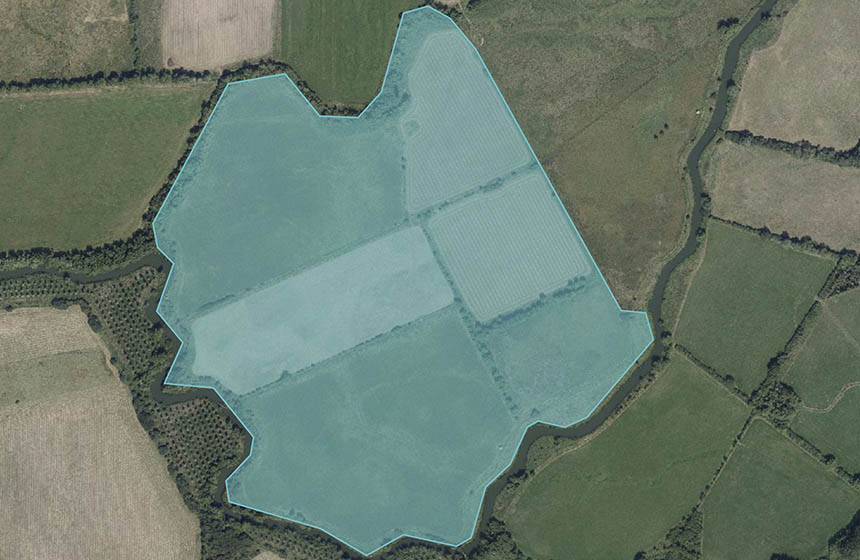Hogacre Common Community Eco Park
Established on a former sports ground, Hogacre Common Eco Park is now a thriving community hub focused on improving biodiversity, climate action, local food production, education and access to nature.
Nature-based intervention:
Starting as a sports ground with tennis courts and a pavilion, the site now supports a variety of different habitats and activities, delivering multiple benefits for people and nature from a small plot of urban land. Projects to improve biodiversity on the site include the conversion of tennis courts into an edible food garden in 2011, the restoration of a wildflower meadow, bee colonies, and planting a lowland woodland, hedgerow and orchard (1). The food garden also serves as a community space to learn sustainable food-growing techniques (2). Following a sustainability report in 2021 (3), each year the project adopts one theme (e.g. water, biodiversity) and implements initiatives to address issues. The water topic in 2021 encouraged the collection of more rainwater to water trees and the food garden. In 2022, the biodiversity theme led to the implementation of a project to monitor biodiversity of plants, invertebrates and vertebrates, soil health, and carbon sequestration in partnership with the University of Oxford.
Overview of context and outcomes:
Once used as a sports field for Corpus Christi College, the 14 acre site was leased to a community group in 2010 for a jar of honey each year. This led to the establishment of Hogacre Common Eco Park Community Interest Company, to develop an Eco Park on the site. There is a strong focus on community participation and education, including through working with local schools and disadvantaged groups.
Case effectiveness on
Climate change
Studies of soil carbon sequestration are underway in partnership with the University of Oxford, aiming to establish whether increases in soil carbon have occurred since converting the site from a sports pitch to a mix of semi-natural habitats. Results have not yet been reported (3).
Strategies to increase adaptation to climate as part of the project remain unreported.
Ecosystem health
Ecological effect: PositiveGrassland on the former cricket ground was allowed to grow into a lowland meadow habitat, with natural regeneration supported by active planting of plug plants. The planting of wildflower habitats reportedly supports bee colonies at Hogacre common which are cared for by a group of trained natural beekeepers. Around 1000 deciduous trees have been planted to establish a 3 acre lowland woodland and hedgerow, including rare varieties of local heritage apple trees.
Socioeconomic outcomes
Hogacre Common provides spaces for community activities and projects. Volunteers are invited to support tree planting, hedge-laying and other management activities during work parties. The park is used as a site for Forest School programmes for local primary school students and for Peers Projects, which gathers children who are not in mainstream education to take part in self-chosen activities and projects for outdoor learning. In addition, wheelchair ramps are built across the park to facilitate access.
Governance
Local participation in Governance: ActiveThe Eco Park is led and managed by a Community Interest Company (CIC), Hogacre Common Eco Park CIC, that comprises volunteers and local residents. Initiatives are run in partnership with local organisations, businesses and community groups.
Finance
The site receives funds from the Feed in Tariff from a solar array on nearby houses donated by West Oxford Community Renewables (WoCoRe). A number of grant applications have been successful, including £5000 in 2019 from the Campaign to Protect Rural England (CPRE) for community engagement and access projects and the purchase of trees for planting. In addition, the pavilion is hired out for events such as awaydays, training days and children’s parties. Other fundraising activities are also carried out.
Monitoring and evaluation
Projects to monitor biodiversity, soil and carbon sequestration are ongoing, including studies of soil carbon stock and surveys on ground invertebrates conducted in 2023 by the University of Oxford. Piezometers are used to monitor groundwater levels and its impact on the floodplain meadow and habitat creation (4). Other species observation projects are also ongoing, through citizen science and research partnerships.
Trade-offs and limitations
No information yet available on tradeoffs.
References
- Hogacre Common. 2021. Welcome to Hogacre. https://www.hogacrecommon.org.uk/
- OxGrow. 2024. OxGrow. https://oxgrow.org/
- Giacomo. 2021. Hogacre Common Eco-park environmental sustainability assessment (ESA) report. https://www.hogacrecommon.org.uk/wp-content/uploads/2022/11/SustainabilityReportPart12-1.pdf
- CH2M. 2017. Oxford flood alleviation scheme: Environmental update.https://consult.environment-agency.gov.uk/thames/ofas-updates/user_uploads/es-app-b-1-environmental-scoping-update.pdf

Intervention type
- Created habitats
- Food production
Ecosystem type
- Temperate forests
- Temperate grasslands
Instigators
- Community/self driven
- Local private sector
Societal challenges
- Biodiversity conservation
- Rights/empowerment/equality
- Food security
Outcomes
- Food security: Positive
- Water security: Positive
- Health: Not reported
- Local economics: Not reported
- Livelihoods/goods/basic needs: Not reported
- Energy security: Positive
- Disaster risk reduction: Not reported
- Rights/empowerment/equality: Positive
- Recreation: Positive
- Education: Positive
- Conflict and security: Positive
- No. developmental outcomes reported: 7
Resources
Read resource 1Literature info
- Grey literature




